Norvic
Philatelics
Royal Mail Horizon Postage
Labels - Summary
Update - new format from Epson printers,
added July 2007
Early in 2002 after
successfully installing computer terminals in all post office branches,
Royal Mail followed the lead set by postal authorities in the USA,
South Africa, Spain, Australia, New Zealand and elsewhere, by producing
at the post office counters labels to be used instead of stamps. These
are known, after the computer network, Horizon
labels. Unlike some other countries the British labels indicate the
postal service for which payment is made. But also unlike some other
countries, the British labels are plain white labels, printed in black.
In
January 2004 Royal Mail introduced 'Smartstamp',
a system which allows users to produce postage impressions -
confusingly referred to as 'Postage Marks' on a personal computer. For
more about the system and examples of the product, click here .
On this page I have described
the rationale behind the move to labels, and given some details of the
initial trials and the timetable for introduction across the country.
At the foot of the page I show labels of various types. And I have also
discovered why an unintended consequence of the introduction will be of
benefit
to collectors who may have thought that their chances of finding
fine-used stamps had reduced.
The trials
On 14 February 2002, Royal Mail
started trials of a new postage label, to be printed at post office
counters. This initiative, promoted by Consignia's Business and
Consumer Markets Directorate, was trialled in about 650 post office
branches in the Edinburgh, Southampton, and Watford postcode areas (EH,
SO, WD). So confident was Royal Mail about the success of these trials
that they announced in April that the scheme would be rolled-out to all
17,500 branches by the end of May 2002, and the Philatelic Bulletin
reported extension to Portsmouth (PO) and two London areas on 9 May. In
the event the trials produced useful information which was used to
modify the system and the nationwide launch was delayed until August - See
below.
Why use labels?
With my accounting background,
it is difficult to argue against the economics of the new labels, which
will help to solve two major problems, and should achieve manpower and
financial savings.
The inland mail is divided into 1st and 2nd class for letters and
packets weighing up to 750gr, the higher cost of first class being
reflected in priority handling and earlier delivery. But if a mixture
of stamps is used, how quickly can postal sorters decide whether a
packet is 1st or 2nd class? In Europe, where blue 'Priority' labels are
used, this is easy. Not so in Britain. Consequently if there is any
doubt, the postman will assume 1st class, otherwise the item might be
delayed into the 2nd class stream, which may bring complaints.
Secondly, all postage stamps must be cancelled to prevent re-use. While
ordinary letters - inland up to 60gr and international up to 20gr - can
be machine processed, most items of mail over these weights cannot be
machined, and the stamps have to be hand-cancelled at the sorting
offices. Royal Mail estimate that over 500 million items a year fall
into this category, of which 80% are posted at post office branches.
This labour-intensive operation will be avoided by the use of labels
for items in these categories, as these labels will not be postmarked.
Label Types
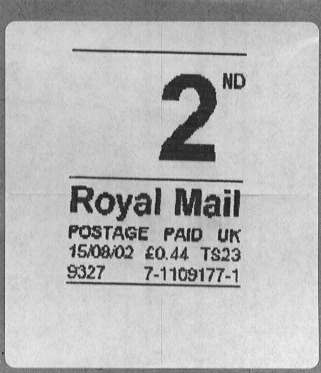
This label is for a 2nd
class packet with postage costing £0.44, ie weighing
101-150gr. The service indicator in the top segment shows 1st
for first class, A
for international airmail, S
for international surface mail, SD
for special delivery, and P
for parcels. Earlier PF
had been used for parcels indicating 'ParcelForce' the division of
Royal Mail responsible for parcels at that time.
Illustrations of these have been added
at the end of the page.
The labels can also be used for inland Recorded Delivery, and the
following international services:
International Recorded,
International Registered,
Swiftair,
Swiftair+Registered, and
Swiftair+Recorded.
These have now been replaced by
Airsure, Swiftair and 'International Signed For'.
Coloured service indicator labels and bar-codes will continue to be
used on these priority services.
At this stage the labels will
not be used for international parcels or mail to British Forces.
Size
and format
The labels are 59x65mm [2.3x2.6"] and are plain white with no
preprinting (unlike the US ones, with the pink strip at the top). As a
security measure each label has four 2cm cuts, one from the centre of
each edge towards the centre of the label. [These can be seen in the
picture above.] This is to prevent reuse, as in similar (but more
colourful) labels from Spain and Portugal. According to the British
Philatelic Bulletin the printing is by ink-jet, but the machine sounds
like an old dot-matrix printer!
The labels are not
available in mint condition,
and as they contain information which identifies the machine (and
therefore the branch) which produces them, action will be taken against
staff if any unused examples are on the market. (They are not sold by
the Philatelic Bureau.)
The national roll-out
The scheme was extended
nationally in three phases from 8 August 2002. The first phase was in
London, Scotland, Northern Ireland, and south-east and the very north
of England. Phase 2 the following week includes north Wales, central
england and East Anglia. Phase 3, on september 5, includes south Wales,
south & west England, and the rest of northern England, as
shown in the table below.
|
Phase 1 - 8 August |
Phase 2 - 15 August |
Phase 3 - 5 September
|
CT
CR
BR
SM
DA
BN
RH
HA
UB
KT
ME
TN
TW
EC
WC
E
N
NW
SE
SW
W
RM
IG
SS
AB
ZE
BT
CA
DG
DL
DH
TS
G
ML
KA
PA
IV
HS
KW
NE
SR |
Canterbury (Kent)
Croydon (Surrey)
Bromley (Kent)
Sutton (Surrey)
Dartford (Kent)
Brighton (Sussex)
Redhill (Surrey)
Harrow (Middlesex)
Uxbridge (Middlesex)
Kingston-u-Thames (Sy)
Medway (Kent)
Tunbridge Wells (Kent)
Twickenham (Middlesex)
London EC
London WC
London E
London N
London NW
London SE
London SW
London W
Romford (Essex)
Ilford (Essex)
Southend-on-Sea (Essex)
Aberdeen
Shetland (Lerwick)
Belfast
Carlisle
Dumfries & Galloway
Darlington
Durham
Teesside
Glasgow
Motherwell
Kilmarnock
Paisley
Inverness
Western Isles (Harris)
Orkney (Kirkwall)
Newcastle
Sunderland |
B
CH
LL
CV
GL
HR
WR
HP
WV
WS
ST
DY
OX
RG
SY
TF
LD
SN
CB
SG
CM
CO
DE
IP
LE
MK
LU
NN
NR
NG
PE |
Birmingham
Chester (Cheshire) #
Llandudno #
Coventry (Warwickshire)
Gloucester
Hereford
Worcester
Hemel Hempstead (Herts)
Wolverhampton
Walsall
Stoke-on-Trent (Staffs)
Dudley
Oxford
Reading (Berkshire)
Shrewsbury (Shropshire) #
Telford (Shropshire)
Llandrindod Wells #
Swindon (Wiltshire)
Cambridge
Stevenage
Chelmsford (Essex)
Colchester (Essex)
Derby
Ipswich (Suffolk)
Leicester
Milton Keynes
Luton (Bedfordshire)
Northampton
Norwich (Norfolk)
Nottingham
Peterborough (Cambs) |
BL
WN
BD
HD
HX
CW
WA
DN
LN
HU
LS
HG
WF
L
M
OL
PR
FY
BB
LA
S
SK
YO
BH
DT
BS
BA
TA
CF
NP
EX
TQ
GU
PL
TR
SL
SA |
Bolton (Lancashire)
Wigan (Lancashire)
Bradford (Yorkshire)
Huddersfield (Yorkshire)
Halifax (Yorkshire)
Crewe (Cheshire)
Warrington
Donacaster (Yorkshire)
Lincoln
Hull
Leeds (Yorkshire)
Harrogate (Yorkshire)
Wakefield (Yorkshire)
Liverpool
Manchester
Oldham (Lancashire)
Preston (Lancashire)
Fylde Coast (Lancashire)
Blackburn (Lancashire)
Lancaster (Lancashire)
Sheffield (Yorkshire)
Stockport (Lancashire)
York
Bournemouth (Hampshire)
Dorchester (Dorset)
Bristol
Bath (Somerset)
Taunton (Somerset)
Cardiff #
Newport #(Monmouthsire)
Exeter (Devon)
Torquay (Devon)
Guildford
Plymouth (Devon)
Truro (Cornwall)
Slough
Swansea # |
I would be interested to hear of any labels with postcodes FK
(Falkirk), KY (Kircaldy) and TD (Tweed) which should be in phase 1, AL
(St Albans) and EN (Enfield) phase 2, and SP (Salisbury) in phase 3. It
is possible that these were included in the trial areas, being 'close'
to Edinburgh, Watford and Southampton respectively.
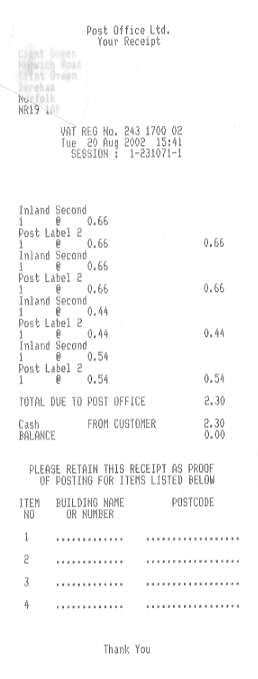
# These postcode areas are wholly or partly in Wales and should
be producing bi-lingual labels, but this is not always the case.
Another extra - a new
certificate of posting
The computer terminals now installed at counters nationwide produce
receipts (on request) for any purchase. As the items bearing labels are
handed over the counter, the receipts for labels can also serve as a
certiciate of posting, as shown below. If less than 4 items are posted,
unused spaces should be struck through. Because the name of the post
office branch and the date are shown on the receipt, this does not need
to be datestamped. But for postmark collectors, traditional
certificates will still be available.
The end of stamps?
Well, no. Counter clerks will
still supply stamps to those who want them. Also, the system has
drawbacks which actually makes it slower to issue the labels than
stamps. The computer has a 'quantity' facility for stamps, but not for
these labels. So if you have six 550gr packets at £1.60 it is
quicker to tear off 6x £1.50 stamps and 6 x 10p stamps than
to produce 6 individual labels.
At sub-post offices, which are owned as businesses by small
shop-keepers, the postmaster receives a payment based on business
throughput. I understand that the payment is less
when labels are used than when stamps are used: this may explain why
some postmasters are keen to continue the use of stamps rather than
labels, especially as the computer is not linked to the scales so there
is little benefit of speed!
Update
March 2004.
With effect from 31 March 2004, all stamps with a face value over
£1 will be withdrawn from post office counters so that they
cannot be used on packets and parcels. The £1.50,
£2, £3, £5 stamps will only be available
in bulk by mail order to Royal Mail's business customers, and from the
Philatelic Bureau and Counters.
Mixed
Franking??
This is a definite possibility, and it will be interesting to see how
inventive collectors can be in creating covers bearing a combination of
stamps plus a label. No item can bear two labels, because any fee can
be paid on one label. In the event that a customer changes his mind -
say from 2nd class to 1st class - or upgrades to special delivery after
a label has been produced, the extra postage should be shown by stamps.
Any item bearing two labels "will be treated as suspicious and will be
investigated".
New
source of Very Fine Used stamps
For collectors the new labels, and the ability to mix labels and stamps
does open up a new facility. Collectors of British postage stamps have
known for years how difficult it is to get very-fine-used (VFU) copies
of any stamp. Ordinary letter rate stamps have a machine postmark,
higher value stamps on packets have ugly black rubber postmarks, either
round(ish) for letters and packets or rectangular for parcels*. Postal
items bearing these labels will not be cancelled at the sorting office.
But
- if the postage is partly paid by stamps, then those stamps must be
cancelled at the branch when the label is affixed for the balance of
the postage cost. And that cancellation must be done with the branch's
steel counter date stamp - the very thing that collectors of VFU want!
[* update September 03 - I understand that the rectangular parcel post
handstamps have been withdrawn.]
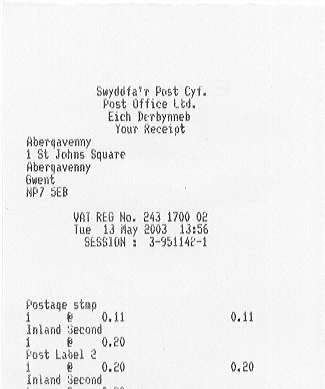
Update - actual treatment of
labels in the post
It is no surprise that labels
have not always been treated in the way that the system intended. I
have received one packet on which the label has been clearly
postmarked, and another which has a postmark, but not on the label.
(Both are shown in the images table below.) Watch this space for more
reports!
Update - Wales is different!
Current UK legislation requires
widespread use of the use of the Welsh language in Wales. Public signs,
postal rate leaflets, Special Delivery labels, internal signs and voice
announcements ("Please go to position 3") have Welsh versions. This is
also the case with these labels, as shown at the foot of this page. Two
lines are added between 'Postage Paid UK' and the variable date/value
information. Post Brenhinol
= Royal Mail. Talwyd Y Post DG
= Postage Paid UK. The till receipt is also adapted, but with the
minimum of Welsh content in lines 1 & 3 - Swyddfa'r
Post Cyf. and Eich
Derbynneb. The first line on the
receipt is for an actual stamp rather than a label.
Update - new typeface
& layout - August 2003
From August 2003 labels
appeared in a new format
with the 1st & 2nd class indicator placed centrally and a
different typeface, with 'nd' and 'st' in lower case - see below. This
label from LL53 (North Wales) is entirely in English, not the first
time non-Welsh labels have been seen from this Welsh-speaking area.
Update - new typeface
& layout, Wales - August 2003?
The earliest Welsh label we
have in the new format is December 2003, so we cannot be certain of the
actual date of introduction of the new format which incorporates a change
to the service designation. In
English, 'second' is abbreviated as 2nd.
The Welsh for 'second' is 'ail', so the Welsh 2nd class label now reads
2 il
- see below.
Update - AX
for Airsure - May 2005?
Normal airmail labels have A
on. I posted an Airsure packet to the USA and the label was printed AX.
The postmaster didn't recall seeing AX before, so we don't know when
this started. I asked the customer for a scan of the label for this
page and it is shown in the table below. Parcel
labels have changed again, from P
to SP
(= Standard Parcel). I have been told by a correspondent of an example
dated 20 October 2003 which is much earlier than I thought. If you have
an earlier date, please let me know (link at the foot of the page).
I'm told that the sheet of 2 labels is now narrower
than originally, which means that the impression is not printed
centrally on the label. But the size of the label remains the same.
This will account for any off-centre
labels you see from spring 2005 onwards. (See July 2009 for
change to AAX)
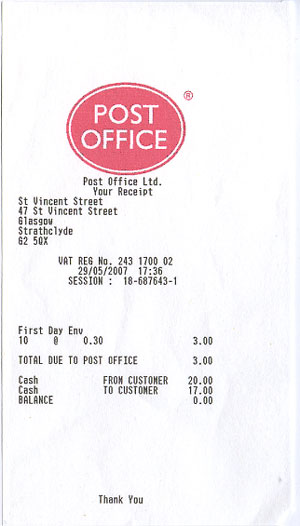
Update - Epson Printers,
spring 2007
I understand that these were
trialled in September 2006 but my informant did not say where, and I
hadn't seen any of the new labels. Epson printers are being gradually
introduced at all post office branches. A special delivery (SD)
example of new label from Glasgow (postcode G2) is shown at the foot of
the page. The most noticeable difference is that the bottom line
is only 2mm high instead of nearly 3mm. The overall height of the
printed area is 38mm compared
with 41mm from the old printers, but the size of the labels remains the
same (65mm).
The other change that the Epson
printers bring is the use of colour and a new format for receipts.
These now show the Post
Office
logo in red, as show here.
Update - PIP changes, November
2007
Fifteen months after the
introduction of Pricing in Proportion and the sale of appropriately-marked
adhesive stamps, changes were
made to the Horizon labels. 2nd
was replaced by 2L,
2LL
or 2PK.
!st class changed in a similar way, and British Forces mail
adopted the designations BL,
BLL
& BPK.
At about this time Royal Mail or Post Office limited prevented the use
of the labels for basic rate mailpieces. This means that simple
letters must be over 100gr to get a label - which means in turn that
they are no longer simple letters but Large Letters! Apparently
even a partly-paid simple letter cannot receive a label for the make-up
value. I understand, however, that a simple letter sent by the
Recorded Delivery service can have any shortfall made up with a Horizon
label, which would be 1L 2L or BL.
Update - Golden Machin label -
8 June 2009
This is such a big unannounced
development that we've given it a separate
page.
Update - no longer 1LL - 27
July 2009
A further unannounced change
took place in July 2009 when the LL
designations were changed to LG,
thus 2LL
became 2LG,
etc. Some say this is tied in with the introduction and
possible nationwide use of a label bearing the Queen's head.
Some have said that there could be adverse comment from some
of the non-philatelic press (insert
the name of any
appropriate newspaper here!) regarding
overprinting the Queen's head with the word ILL. At the same time Airsure
changed from AX to AAX for some reason.
Pictures of these, including Welsh versions will be added as
soon as we have time to scan them. (If anybody has an AAX label,
please contact us on the link below.)
How to obtain covers with
labels
Given the volumes which Royal
Mail expects to be processed with these labels, there should be no
shortage. The difficulty will lie in finding covers or portions of
parcel wrappers which are good enough to be collected. These labels
certainly have a place in exhibition displays of postal history*, but
finding 'better quality' items will be difficult. Of course, collectors
can send letters to themselves as they always have done; and the
inclusion of some heavy card (or lead!) will increase the weight of the
letter.** But it should also be possible - as it is with stamps - to
overstate the weight of the letter and pay extra.
Royal Mail have
suggested that they will not normally expect labels to be applied to
envelopes as small as DL-size (110x220mm). Time will tell. The 'danger'
in applying labels to DL envelopes is that they will be
machine-processed and receive a postmark, although this is less likely
with 'premium' items as with the Special Delivery envelope shown at the
foot of the page.
* Indeed, a display by Lincoln Philatelic Society at StampLincs 2003
included a 12 page display, including early trial items.
** This should not be necessary - I recently posted basic rate (20gr
inland) letters with labels. Update - see November 2007 entry.
If you would like to receive
envelopes bearing these labels, please email
Norvic Philatelics - note that this is not a free service, given that basic
letter labels can only be obtained for the more expensive (75p
currently) recorded delivery service, and Large letters have to be
101gr (which currently costs 90p for 1LL and 76p for 2LL).
Return to
H O M E page
This page created 21 February 2002 and modified 15 August 2009.
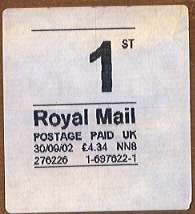 |
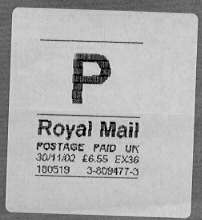 |
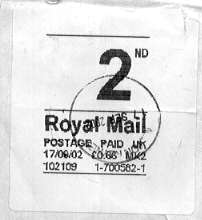 |
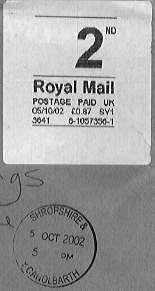
|
| 1st
class label from NN8
(Northampton) area 30 September 2002 for letter packet weight 1-1.25kg,
postage £4.34 |
Parcel
label from EX36 (Devon) 30 November 2002 for parcel of between 2kg and
4kg, postage £6.55.
[In early trials, parcel labels showed PF
for ParcelForce.] |
2nd
class label unnecessarily and
incorrectly postmarked at Milton Keynes 17 September 2002 |
2nd
class label from Shrewsbury
centre (SY1) with bi-lingual postmark SHROPSHIRE & Y CANOLBARTH
(Mid-Wales) |
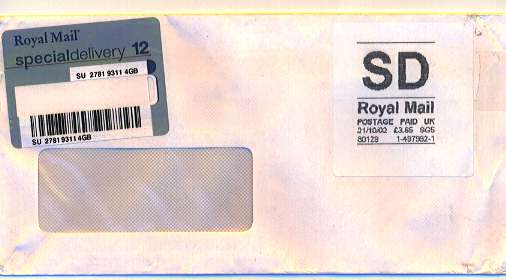 |
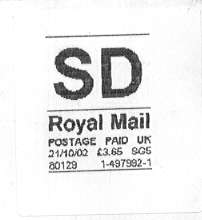 |
| (Above)Special
Delivery business envelope, with
silver bar-code label applied correctly at top left, and SD
postage label for £3.65, posted 21 October 2002 in Stevenage
area (SG5). |
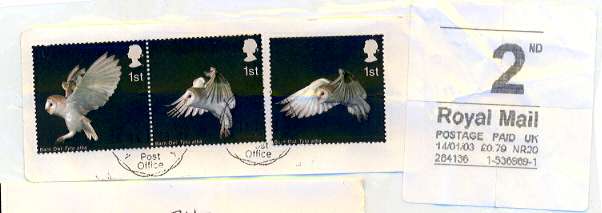 |
<<<<
This 79p 2nd class label is on a 500-600gr packet (postage rate
£1.60), where 81p has been prepaid. Note the stamps have been
cancelled with the counter handstamp. |
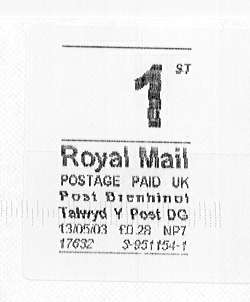
|
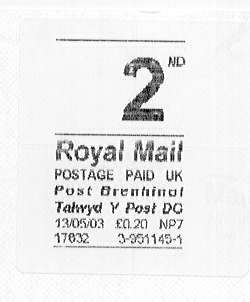
|
< < Left
1st & 2nd class
labels from Abergavenny (NP7) with the additional Welsh language lines
above the date. These are both basic rate 20gramme letters at the new
rates of 28p and 20p effective 8 May 2003. |
 |
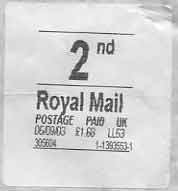
|
<
< Left
From August 2003 labels appeared in a new
format with the 1st &
2nd class indicator placed centrally and a different typeface, with
'nd' and 'st in lower case. This is also from a Welsh area (LL53) but
is solely in English.
Right
>>>
The new format label in Welsh shows the correct designation 2il
instead of 2nd as shown on the Abergavenny labels above. This one is
also from the Llandudno area (LL38). |
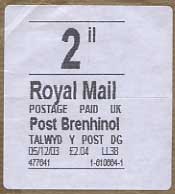 |
^^^^
Probably introduced in spring 2005 this AX label for Airsure, used with
stamps prepaying a packet to the USA.
See paragraph above.
|
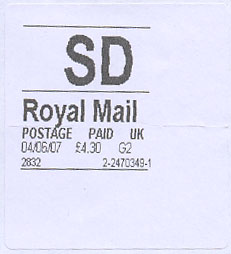
|
<
< Left
English language label from new Epson printer introduced in spring
2007, overall height reduced to 38mm. Last line now 2mm.
>>
Right
Welsh language label from new Epson printer from Swansea area, SA2.
Zero value because the postage and fee had been prepaid in cash. |
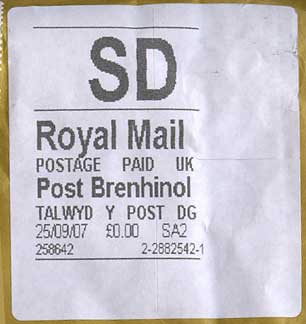 |
New
January 2004 - SmartStamps
- postage via the PC - see a
page of
specimens and covers.
New
June 2009 - Machin head on
Golden Horizon label
- Details
and pictures!
Contact
us
HOME

















